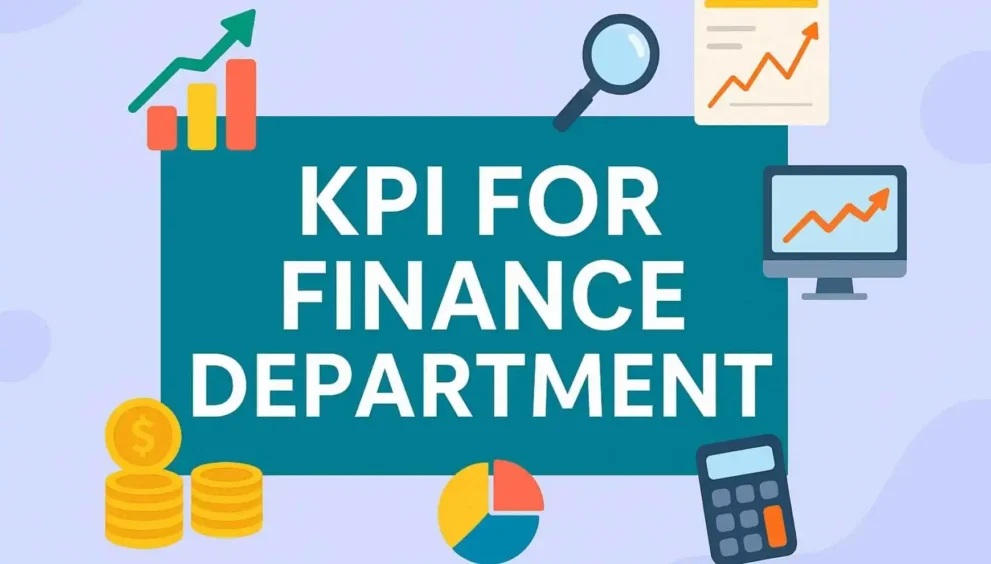Understanding KPI for Finance Department — From My Experience
I still remember my first day on the finance team at a fast-growing company. Back then, I thought if you just tracked expenses and sent reports on time, that was enough. But over the years, I realized how powerful the right KPIs (Key Performance Indicators) can be for a finance department. The right KPI for finance department efforts can truly transform how decisions are made. They’re not just numbers—they’re the heartbeat of how a business runs financially.
In this article, I’ll break down what KPI for finance department means, why it’s important, and how to actually make it work in the real world. And I’ll do it in plain English, no confusing terms. Just helpful insights that I’ve learned on the job.
What is KPI for Finance Department?
KPI for finance department simply means the key things you track to understand how well your finance team is doing.
Think of it like a scoreboard in a sports game. Without it, you have no way of knowing whether you’re making progress or falling behind. For finance, KPIs help track money coming in, money going out, debts, profits, and more.
Some common examples of finance KPIs are:
- Net profit margin
- Operating cash flow
- Accounts payable turnover
- Budget variance
- Return on investment (ROI)
But here’s the thing: it’s not about tracking every single number—it’s about focusing on the ones that actually matter. It’s about tracking the right ones that matter for your company.
Read More > Can You Trade in a Financed Car? Here’s What I Discovered the Hard Way
Why KPI for Finance Department Matters
So, why does this even matter?
Because without the right KPIs, you’re basically running your finance team in the dark. You won’t know where your money is leaking or where you could be doing better.
For example, in my first year at a new job, we didn’t track our accounts receivable days. We thought we were doing fine. Turns out, our clients were taking almost 90 days to pay us—and we had no idea. Once we started using that KPI, we fixed the payment system and got our money faster.
Tracking KPIs keeps your business healthy, stable, and ready to grow.

Key Benefits of KPI for Finance Department
Once I got the hang of using the right KPIs, I saw a major difference. Here’s what I noticed:
1. Better Decision Making
With clear numbers in front of me, I could give better advice to management. Should we cut costs? Should we invest in new software? KPIs gave me the answers.
2. Early Warning Signs
One time, our budget variance KPI showed a sudden spike. We caught an internal error that could’ve cost us thousands. That one number saved us big time.
3. Team Accountability
Each team member knew what metric they were responsible for. No more guessing or finger-pointing. Everyone knew their part.
4. Easier Goal Tracking
It felt great to see progress month after month. Watching our gross profit margin go up was like a mini celebration every time.
Common Misunderstandings or Mistakes
Now, let’s talk about the mistakes I’ve seen (and made myself):
- Trying to track too many KPIs: More is not better. It just makes things messy. Focus on 5–7 solid ones.
- Not updating them regularly: A KPI only works if you look at it often. Weekly or monthly updates are key.
- Chasing vanity metrics: They might look impressive, but they don’t actually tell you anything useful. Like total number of spreadsheets made. Stick to metrics that impact money and performance.
Real-World Examples of Finance KPIs in Action
Let me share one real example that still sticks with me.
I worked with a medium-sized company that always felt “broke” by the end of each quarter. But they were making sales. So, we introduced a KPI to track cash flow forecasts. Within three months, we discovered that their client payments were lagging, and supplier payments were going out too early. After adjusting a few payment terms, our cash flow stabilized—and that constant “broke” feeling disappeared.
Another time, we used the budget variance KPI to spot a department that kept overspending. We set new rules, and by the next quarter, they came in 8% under budget.
That’s how real this stuff gets.
How to Get Started With Finance KPIs
If you’re new to this, don’t stress. Here’s what helped me:
Step 1: Talk to the team
Find out what challenges your team faces. Late payments? Missed targets? That helps decide which KPIs to track.
Step 2: Pick a few KPIs
Start small. My favorites to begin with are:
- Net profit margin
- Accounts receivable days
- Cash flow from operations
- Budget variance
Step 3: Set goals
Don’t just track—set targets. Like reducing receivable days from 60 to 45.
Step 4: Review regularly
Hold monthly review meetings. Use visuals like simple charts. It keeps things clear for everyone.
Step 5: Adjust when needed
If a KPI isn’t helping, change it. As your business grows, your KPIs should adapt and evolve to match its changing needs.
My Final Thoughts
When I first heard the term KPI for finance department, I’ll admit—I thought it sounded like something only big corporate teams used. But now, after years of working in finance, I know this: even the smallest business can benefit from tracking the right numbers.
It’s not about being fancy. It’s about being smart. And consistent.
If you’re just starting out, don’t worry about being perfect. Just start. The sooner you start, the more control you’ll gain over your business’s financial direction.
Trust me, the numbers will guide you.
Frequently Asked Questions (FAQs)
What are the most important KPIs for a finance department?
Some of the most helpful KPIs are:
- Net profit margin
- Operating cash flow
- Budget variance
- Accounts receivable and payable days
- Return on investment (ROI)
These metrics help you monitor your income, expenses, and overall financial well-being.
How often should finance KPIs be reviewed?
Monthly reviews work best for most businesses. Some, like cash flow, might need weekly check-ins.
Can small businesses use finance KPIs too?
Absolutely. You don’t need a big team or fancy tools. Even a spreadsheet works. Begin with the basics and expand your metrics as your business grows.



